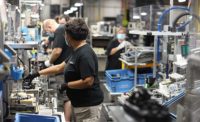La-Z-Boy is one of the best-known brands in the residential furniture industry. The company is synonymous for its comfortable reclining chairs. But, La-Z-Boy is also well-known for lean manufacturing and its made-in-the-USA production philosophy.
The company operates five assembly plants in the United States that mass-produce all types of custom-made La-Z-boy upholstered furniture. In addition to the iconic reclining chair, which La-Z-Boy pioneered back in 1928, the company makes a variety of other products, including stationary chairs, lift-chairs, sleeper sofas, modular seating units, ottomans, love seats, tables, desks and bedroom furniture.
La-Z-Boy’s 1.2-million-square foot plant in Dayton, TN, is the company’s flagship operation and one of the largest furniture factories in the United States. While other American manufacturers have struggled in the past decade due to foreign competition, the 41-year-old factory has thrived because of its lean manufacturing initiatives.
As many furniture manufacturers shut down plants and outsourced production 10 years ago, La-Z-Boy adopted the Toyota Production System and began converting its plants to cellular manufacturing. The effort has paid off by improving time to market, reducing scrap, increasing quality and boosting productivity.
“Our American-made advantage allows us to provide the fastest custom-order furniture delivery possible, a feat none of our competitors with outsourced production facilities can match,” claims Kurt Darrow, president and CEO of La-Z-Boy Inc. “Our Dayton facility is a world-class manufacturing operation that is unmatched by others in the industry.”
Since going lean, La-Z-Boy has reduced its operating expenses by approximately $50 million a year. Production cycle times at the Dayton plant have improved by more than 600 percent. Over the past three years alone, productivity has improved by 42 percent while scrap has been reduced by 71 percent.
As a result, consumers can buy a basic recliner model today for about the same as what it cost when the Dayton plant opened in the early 1970s. And, because of productivity improvements, the plant can produce as much today with 1,300 employees as it did with nearly twice as many people 20 years ago.
La-Z-Boy Tennessee began its lean journey in 2005 as part of a corporatewide effort to reduce waste, streamline production processes and cut operating costs.
“By deploying lean manufacturing principles throughout our Dayton operation, we have reduced costs and seen considerable improvements in our waste reduction, throughput times, safety of our work environment, and the quality of our products,” says Darrell Edwards, senior vice president of operations at La-Z-Boy. “We have also extended lean principles to nontraditional areas, such as within our safety program and our office environment; and we have seen similar success.
“We produce a wide breadth of product line throughout the Dayton plant,” adds Edwards. “There’s a unique blend of volume-based styles, as well as a wide array of custom units produced within the same facility. Terrific people are what make not only our Dayton plant, but the entire La-Z-Boy organization, unique. We believe we have the greatest employees in the furniture industry.”
Proud Heritage
La-Z-Boy is headquartered in Monroe, MI. It’s the same small town where two cousins, Edward Knabusch and Edwin Shoemaker, created a new type of chair in their family’s garage back in the late 1920s. Their wood-slat porch chair featured a seat that moved forward as the back reclined. Within a year, the cousins were producing an upholstered version of the chair for year-round indoor use.
Production of the popular chairs was outsourced to several furniture manufacturers in the 1930s, because Knabusch and Shoemaker couldn’t keep up with demand. But, by the end of the decade, they decided that making La-Z-Boy chairs in their own factory was the only way to consistently maintain quality and reduce costs.
In 1941, a new 27,000-square-foot assembly plant was built in Monroe. During World War II, the factory mass-produced seats for ships, tanks and trucks.
To meet pent-up demand after the war, La-Z-Boy engineers revamped the factory floor and installed a moving assembly line. It consisted of a series of small workbenches on wheels that were conveyed along tracks in the floor. The automated line increased production volume because operators only handled one assembly task. In the past, assemblers had each built entire chairs at stationary workstations.
In the late 1950s, La-Z-Boy engineers developed the world’s first reclining rocker. The Reclina-Rocker boasted three new features when it debuted in 1961: it reclined, it rocked and it had a built-in footrest. The chair used a new type of recliner mechanism that revolutionized the furniture industry, just as the television craze was peaking. As a result, La-Z-Boy’s sales skyrocketed from 1 million units in 1961 to 150 million units by 1971. Backlogs of nine months or more were common (today, it’s been reduced to just a few days).
That phenomenal growth prompted La-Z-Boy to open a new plant in Dayton, TN, in 1973. Before construction began, Edward Knabusch sat in a reclining chair and pulled the footrest lever, setting off a charge of dynamite that exploded in the distance.
The original 360,000-square-foot building was enlarged in 1986, 1990 and 1999 to increase production capacity. Today, the 56-acre Dayton campus consists of two factories. One facility assembles recliners and motion furniture, while the other one produces stationary furniture and sofas. The combined operation typically produces more than 14,000 units per week.
Other than purchasing fabric and leather from third parties, the Dayton operation is almost entirely vertically integrated. Both buildings are supplied by a metal supply center that stamps and shapes numerous parts used in La-Z-Boy’s proprietary mechanisms. A large automated wood shop cuts and shapes hardwood lumber and plywood that’s used to make frames. A foam shop cuts and trims big polyurethane blocks into various sizes and shapes for use in cushions and padding.
Diverse Products
In addition to manufacturing chairs that recline, La-Z-Boy also makes products that rock and vibrate at the push of a button. Options available on some products include gliding motion, swivel motion, memory foam, heaters, power lumbar support, power-tilt head rests and power seat cushion lifts.
Customers can choose from more than 150 frame styles and 900 cover materials, including many different types of leather, fabric and wood trim options. All that customization adds up to an endless variety of products and complexity on the assembly line. In fact, there are millions of possible product variations at the Dayton plant.
Products are sold through independent furniture retailers and a nationwide network of more than 300 standalone La-Z-Boy Furniture Galleries. Not surprisingly, peak demand is in the fall and winter, coinciding with football season.
The Dayton plant builds approximately 95 percent of its chairs and sofas to order, thanks to a just-in-time inventory and delivery system. But, layout and production flow has changed dramatically in the past decade, due to lean manufacturing.
“Twenty years ago, plant operations included assembly conveyors that stretched for long distances moving product from batch and queue to upholstery workstations,” says Harold McCawley, general manager of the Dayton plant, who began his career on the assembly line several decades ago. “Supply areas had large amounts of WIP in queue from one shift to another waiting to be dispatched to linear conveyor line assembly. Lighting and layout was poor and workstations were not ergonomically friendly.
“Product flow was congested and required many stop-and-go points,” adds McCawley. “Travel distances created non-value-added costs and additional indirect labor to manage the flow.”
The plant floor has evolved into a cellular production system that features one-piece, continuous flow. “Cellular manufacturing permitted us to revise material flow and reduce process time by days and reduce non-value-added labor, while improving productivity,” says McCawley.
Separate departments that were once scattered throughout the plant have been eliminated. In the past, each piece of furniture travelled through various workstations, such as framing, and then moved to the next workstation.
Cellular manufacturing has reduced excessive handling and reduced movement around the plant. Now, small teams work on an entire product, start-to-finish in 31 U-shaped assembly cells.
Teams of six to eight workers build frames and stuff polyurethane into previously cut-and-sewn components. Upholstery is attached to the wood frames using automatic nail guns. Assemblers are also responsible for testing each piece of furniture and for packaging it. An electronic signal indicates that the product is ready to be picked up by a tug and transported to the warehouse.
Assemblers operate on an incentive basis and are managed by a “coach” who supervises up to five teams. Meetings are held daily at each 40-by-50-foot cell. Teams with the lowest customer complaints receive monthly rewards.
Employee morale has been greatly enhanced due to improvements in ergonomics, safety and housekeeping through practices such as 5S and an employee engagement program. For instance, adjustable workstations and tilt lifts have been installed in the cells to help reduce excessive bending and prevent back problems.
“Lean manufacturing enabled us to provide a clean, orderly, well-lit work area,” says Janet Earnhardt, human resource director. “Safety metrics have improved significantly and incident rates have decreased 82 percent over the past 10 years. Participation in safety, quality and suggestion programs progressively improved as our lean processes matured.”
Another benefit of cellular manufacturing at La-Z-Boy’s Dayton plant has been an improvement in error-proofing initiatives that ensure consistent assembly and conformance to quality standards.
“Frame assembly fixtures have been designed for accurate alignment,” says David Robinson, continuous improvement manager. “Each fixture is designed so that parts will only go in a specific orientation to avoid assembly errors. The fixtures are designed with ergonomics in mind, as well as part placement.
“Footrest boards have reference pull-lines clearly printed on them so operators do not over-pull fabric,” adds Robinson. “Sequential batch supply ensures that only the components needed for specific products are supplied just-in-time for assembly, ensuring that incorrect components are not introduced into our products.”









